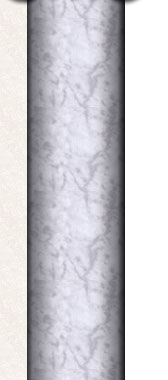A citizen can tell how important or wealthy a person was from their clothing. Free men wear a toga instead of a cloak. The toga is made from white wool or white linen. It is square or rectangular in shape and is worn draped around the body.
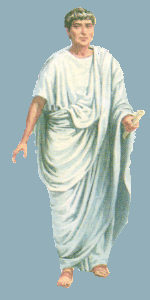 Togas Togas
The toga is a garment of class and distinction. It is most often worn during state occasions. Consuls and senators wear togas edged with purple when attending the senate. Some of the emperors' togas are made entirely from either purple or black cloth. Black togas, though, are usually only worn in times of mourning.
Togas usually look like a white sheet and are typically 9 yards long. They are arranged and wrapped very carefully around the body, and in a stylish way.
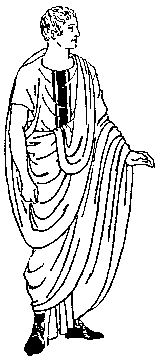 |
 |
| Senator - White toga, purple bands and boots |
Knight - White toga and tunic, purple bands and sandals |
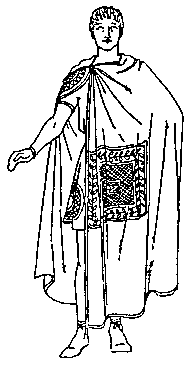 |
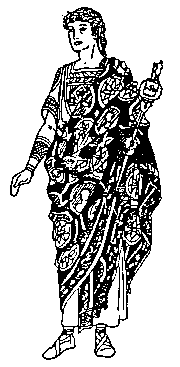 |
| Magistrate - White tunic, purple toga, gold embroidery |
High Rank - White tunic, purple tunic, gold embroidery |
|
|
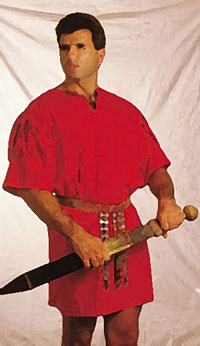 Tunics Tunics
Tunics are worn by all classes. They look like long tee-shirts and are far more practical than togas. Most adult tunics are white and reach to the knees, whereas those worn by members of the military (as shown here) are red and are typically shorter. Tunics are made of cool linen, for summer wear, and warm wool, for winter wear. Sometimes, they are worn with trouser like garments.
Boys wore a tunic down to their knees. It was white. Once a boy became a man, he put aside his childish clothes and wore an all-white tunic and, if he were a free man, a toga as well.
A boy becomes a citizen at age 16. Coming of age, becoming a citizen, is often quite a celebration. On a boy's sixteenth birthday, he dressed himself in a white tunic, which his father adjusted. The day usually ends with a dinner party, given by the father, in honor of the new Il Senso citizen
 Accessories worn by Men Accessories worn by Men
Wigs were worn by men as a disguise and to hide baldness. Rings are typically the only jewelry worn by Il Senso men, and good manners dictates only one ring. Of course, some men do not follow "good taste", a former senator was said to have worn as many as sixteen rings, a few men have been seen wearing necklaces and /or even diadems.
Hairstyles and beards vary, but mostly short hair and clean shaven or closely trimmed beards.
Boys' Bulla
Children wore a special locket around their neck, given to them at birth, called a bulla. The Etruscum aurum is a gold circular amulet that is worn protectively as an amulet. It is a token of as a child needing protection and is set aside with the coming of age, as the child becomes an adult and is considered no longer in need of such protection.
Most often the symbol on the amulet was the holy symbol of the patron deity of the family, but if a deity showed early interest in the child a new bulla would be made in honor of them with their symbol, depending on the deity and type of interest given.
As a protection against evil, it was most often and was worn on a chain, but a cord or strap would suffice for those of lesser wealth. Boys wore their bulla until the day they become a citizen. Boys bullas were put aside and carefully saved. A boy's bulla could be worn by the owner again, if he won special honors. For example, if he became a successful general, and won the honor of triumph, he would wear his bulla in ceremonial parades, to protect him from the evil jealously of men. |






